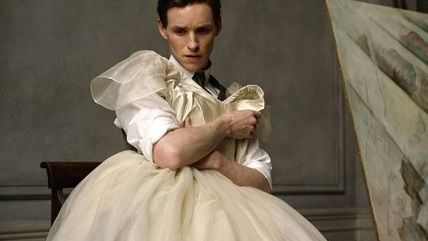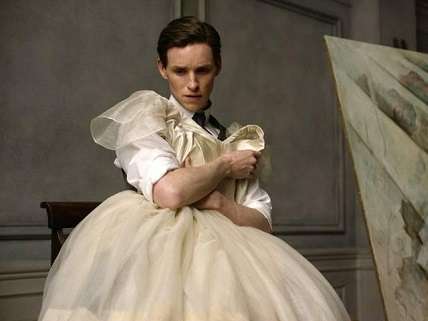Movie Reviews: The Danish Girl and Victor Frankenstein
Eddie Redmayne upstaged by Alicia Vikander, Daniel Radcliffe lost in a limp horror riff.


In The Danish Girl, Eddie Redmayne gives a performance that whispers softly of Oscar. It's a tour de force, no question; but there's something off about it. Playing the Danish artist Einar Wegener, the first man to undergo sexual reassignment surgery, Redmayne, in dresses and heels and primly bobbed wig, concerns himself chiefly with externals. He poses and primps and—the only word—simpers in a way that indicates that his Wegener believes these are the defining characteristics of female gender. People who were born female may object to this retrograde impersonation (as some already have in the case of Caitlyn Jenner). But will Academy voters care? (To help them out, the movie's production notes offer a list of "terms to know"—cisgender, LGBTQ—"when discussing The Danish Girl.")
The story begins in Copenhagen in 1926. Wegener and his wife, Gerda (Alicia Vikander), are both painters. He specializes in landscapes, which are widely esteemed, while she turns out portraits of local notables—a practice that has stalled her career, portraiture being considered a second-rate artistic enterprise. Seeking to broaden her horizon, she decides to paint a new kind of picture, one that will require a female model. Not having a suitable subject immediately at hand, she persuades Einar to don stockings and a dress and pose for her. Their session is interrupted by the arrival of a lively friend named Ulla (Amber Heard, bringing the movie a welcome whoosh of merriment). Gazing approvingly at Einar in his finery, she gives him a new name: Lili. Einar is transformed.
Working from a script by Lucinda Coxon that adapts David Ebershoff's 2000 novelization of the Wegeners' lives, director Tom Hooper (The King's Speech) stages some poetically resonant scenes. As Einar embraces his new female identity—the one he has always felt waiting inside—we see him standing naked before a mirror, running his hands over his breastless chest, tucking his penis away between his legs, dreaming. "I believe that I'm a woman," he tells Gerda. "I do, too," she says.
The Wegeners' story is one of deep devotion—Gerda's support for her transitioning husband is unbounded. When they're out at a party, with Einar dressed as Lili, she introduces her somewhat dowdy companion as Einar's cousin. This strategy is so successful that Lili stirs the amorous interest of a man named Henrik (Ben Whishaw): "I think we might be the same," he says, hopefully. (Unfortunately, while Henrik is homosexual, Einar isn't.) Einar tells Gerda that he did once kiss a boy during his school days, and after they've moved to Paris, where Gerda's Lili paintings have found favor with a local gallery, she seeks out this now-grown classmate. His name is Hans, and he has become a Parisian art dealer. (He's played with quiet cosmopolitan flair by the fine Belgian actor Matthias Schoenaerts.) Hans is attracted to Gerda, but she is unshakably loyal to her husband. Hans accepts this, and is soon drawn to assist his old friend on his journey to sexual emancipation.
It's a turbulent voyage. But after enduring a series of unhelpful doctors (maybe he's suffering from a chemical imbalance, or maybe he's insane, they say), Einar finally connects with a German practitioner (Sebastian Koch) who's ready to try an experimental surgical technique he has devised for sexual reassignment. It will be highly risky, but Einar doesn't care. "This is not my body," he says. "Please take it away."
The movie is a sentimental cheat at the end, but it's stirring in its depiction of a man who is determined—in a very different world—to cast off a societal stricture in pursuit of what he feels to be his true identity, to "correct a mistake in nature." Redmayne approaches this role with painstaking delicacy, but his performance is timorous—it's too one-note. The real star of the film is Alicia Vikander. With a jaunty cigarette holder clamped between her teeth, she brings tones to the role of Gerda that are by turn flinty and wry and surprisingly funny—she fully creates a unique character. In the process of awarding Redmayne another nomination, Academy voters must surely take note of Vikander's more fully realized achievement.

Victor Frankenstein
Victor Frankenstein gets just about everything wrong. The movie is grisly at times, but never scary. It's over-amped, but not exciting. And it's entirely preposterous, which might have been amusing, but isn't.
In a strained ploy to dust off the old Frankenstein story for one more go-round, director Paul McGuigan and writer Max Landis have shifted its focus from the monster to the sniveling hunchback Igor, Frankenstein's demented lab assistant. This is a cute idea, but a bad one. Marty Feldman had fun with this character in Young Frankenstein (taking off from Dwight Frye's performance in the 1931 horror classic). But with earnest Daniel Radcliffe slotted into the role, fun is no longer on the menu. Radcliffe will always be fondly regarded by those who revere the Harry Potter films, but he has proved to be an actor of very limited resources—chiefly a stiff grimace used to signal either puppyish cheer or pained concern. He's always likable, but not equipped to carry a movie. Especially this one.
Radcliffe is introduced as a nameless hunchback circus clown. By day he is tormented by his fellow carnies, but by night…he studies anatomy books in his squalid quarters. He yearns for a pretty aerialist named Lorelei (Jessica Brown Findlay, of Downton Abbey). When she takes a bone-snapping fall from her trapeze, a doctor named Victor Frankenstein (James McAvoy)—visiting the circus in search of discarded animal parts for his unholy experiments—rushes to her side. Victor says he can do nothing to repair Lorelei's damage, but the hunchbacked anatomy student can, and does. "You're not a clown," Victor exults. "You're a physician!"
Okay. Frankenstein springs the bedraggled young man from the circus and takes him back to his lab, a den of picturesque beakers, retorts and crackling arcs of electricity. He diagnoses his guest's hunchback problem as nothing more than a pus-filled abscess (the draining of which provides the movie's most wonderfully disgusting moment). Then he bestows upon the now-presentable lad the name of a previous assistant, Igor, who has mysteriously gone missing (although not for any interesting reason, it later turns out).
Igor joins Victor in assembling a living creature from a mess of monkey parts. (The gruesome result looks like a chimpanzee that's been lightly dunked in a wood chipper.) A show-and-tell at the Royal College of Medicine goes badly, but a snotty toff named Finnegan (Freddie Fox) takes an interest, and agrees to finance Frankenstein's quest to assemble a new creature from human odds and ends. This draws the attention of a priggish Scotland Yard detective named Turpin (Andrew Scott, of Spectre), who telegraphs his disapproval of Frankenstein's God-mocking project by continually fondling a small cross he carries in his pocket.
The movie's production design, by Eve Stewart (who also worked on The Danish Girl), is a gorgeous riot of Victorian clutter. But the director's affinity for winking references to earlier, better Frankenstein films has a leaden effect. (Someone actually says "It's alive!" Someone else addresses Victor as "Mr. Frankensteen.") And McGuigan's attempts to stretch out the thin story with chases and fights and some dull business about Victor's long-dead brother test our patience, and finally defeat it. Nothing he tries can bring this movie to life.


Show Comments (14)